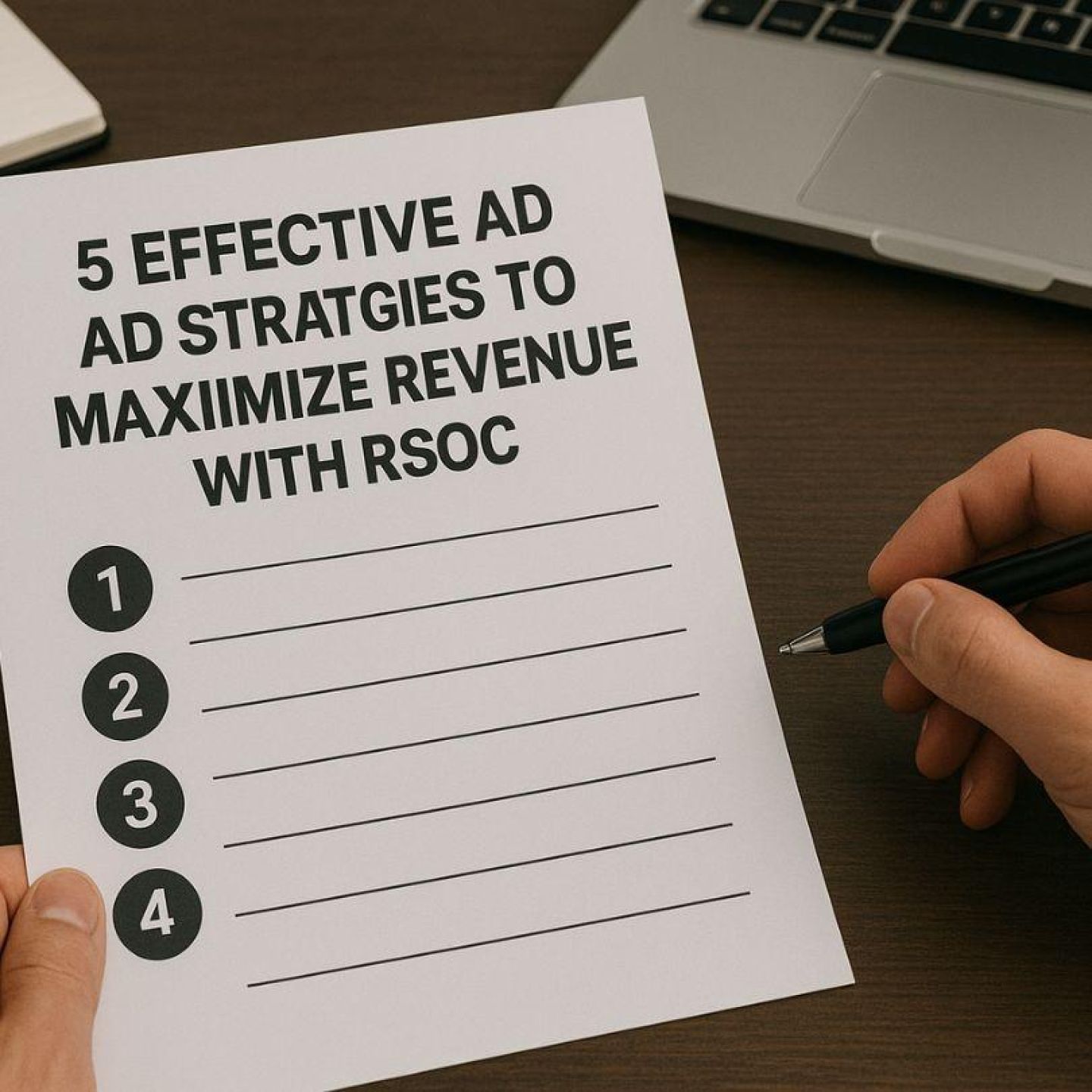
Our tools monitor millions of native, push, pop, and TikTok advertising campaigns.
Get StartedRelated Search for Content (RSOC) is a game-changing method for publisher monetization that completely changes how you show advertising content to your audience. This innovative advertising strategy displays relevant search terms directly on content pages, creating a seamless connection between user curiosity and valuable information.
Maximizing ad revenue has become increasingly challenging for publishers trying to make money online in today's competitive digital world. You need strategies that not only generate income but also maintain user trust and engagement. RSOC addresses this challenge by offering a content-driven solution that prioritizes user experience while delivering substantial revenue opportunities.
The power of RSOC comes from its alignment with native advertising principles. Instead of interrupting the user experience with annoying banner ads or pop-ups, RSOC blends naturally into your content structure. This approach respects user intent by providing educational, image-rich content that genuinely serves your audience's interests.
When you implement RSOC effectively, you're essentially converting paid clicks into high-value organic traffic. Your users encounter ads that feel like natural extensions of your content rather than obvious promotional material. This alignment creates a win-win scenario: your audience discovers relevant information while you generate ad revenue through qualified, engaged clicks.
The strategy works because it recognizes a fundamental truth about modern web users—they prefer content that educates and informs rather than content that simply sells. To further enhance your monetization efforts, consider exploring these ad revenue optimization strategies which offer proven techniques for smarter ad placement and improved earnings.
RSOC benefits extend far beyond traditional advertising approaches by creating a seamless bridge between user search intent and relevant content. This advertising strategy displays contextually relevant search terms directly on your content pages, transforming the typical banner ad experience into something more valuable for both you and your visitors.
The mechanism behind RSOC centers on intelligent content analysis. When users land on your pages, the system analyzes the existing content and generates related search suggestions that align with the page topic. These content-driven ads appear as natural extensions of your content rather than disruptive advertising elements.
The transformation process works by converting what would typically be paid advertising clicks into high-value organic traffic. When users click on RSOC suggestions, they're directed to monetized pages or content-rich websites that provide genuine value. This approach eliminates the common problem of parked domains and low-quality landing pages that frustrate users and reduce engagement.
Publishers experience several key advantages with RSOC implementation:
Compared to traditional formats like AdSense for Feeds (AFD), RSOC delivers superior performance metrics. While AFD relies on generic ad placements, RSOC creates personalized content journeys that match user intent more precisely, resulting in higher click-through rates and sustained revenue growth.
Native advertising, such as those offered by platforms like Anstrex, serves as the perfect complement to RSOC campaigns, creating seamless user experiences that drive higher engagement rates. When you integrate RSOC units with platforms like Outbrain Direct Response (ODR), you're combining the search-driven intent of RSOC with the content discovery power of native ads.
The key to successful integration lies in ad relevance. Your RSOC units should mirror the editorial tone and visual style of your content pages. This approach ensures that ads feel like natural extensions of your content rather than disruptive interruptions. Users encounter search suggestions that genuinely relate to their current reading experience, creating a logical progression in their content consumption journey.
User journey optimization becomes significantly more effective when RSOC ads maintain contextual alignment with page content. Consider a health and wellness article about nutrition - your RSOC units should present related searches like "healthy meal planning" or "vitamin deficiency symptoms" rather than generic terms that break the content flow.
This strategic alignment directly impacts conversion rates. When users click on RSOC suggestions that match their current interests, they're more likely to engage meaningfully with the destination content. You're essentially guiding users toward information they're already primed to consume, resulting in longer session durations and higher-quality traffic signals.
Publisher monetization techniques benefit tremendously from this approach, as advertisers value traffic that demonstrates clear intent and engagement patterns.
Google RAFs are essential tools for managing complex RSOC campaigns effectively. They give publishers precise control over their ad units, allowing for customization and scalability.
With Google RAFs, you can tailor your advertising strategies to better suit your target audience and content themes. Here are some key customization options available:
One of the powerful features of RAFs is their ability to target specific segments of your traffic. This allows you to deliver more personalized ads and increase the chances of engagement. Here are some ways you can segment your traffic using RAFs:
To continuously improve the performance of your RSOC units, Google RAFs offer an A/B testing functionality. This allows you to compare different variations of your ads and see which ones perform better. By analyzing the results of these tests, you can identify the most effective combinations for your traffic and optimize accordingly.
Another valuable feature of Google RAFs is their ability to track clicks on your ads. This provides you with detailed insights into how users are interacting with your advertisements. Here are some key metrics you can track through RAFs:
The upcoming deadline in August 2025 creates a sense of urgency for publishers to ensure they remain eligible for Google RAFs. As this date approaches, Google's compliance requirements will become stricter, making it crucial for publishers to consistently follow policies and generate quality traffic.
If publishers fail to meet these requirements and lose access to RAFs, they may face significant challenges in optimizing their RSOC performance. Industry benchmarks suggest that this could lead to a decline in click-through rates and overall revenue per visitor by 30-40%.
Google policy compliance is essential for sustainable RSOC monetization. Violating these policies can lead to penalties, loss of revenue streams, and exclusion from valuable RAF tools.
Your RSOC implementation must meet specific standards to avoid policy violations:
You must design your pages to prevent user confusion. Misleading layouts that disguise ads as organic content or navigation elements will trigger policy violations. Position RSOC units clearly as advertising content, using proper spacing and visual distinction from your editorial content.
Spam prevention requires you to eliminate aggressive tactics like excessive pop-ups, auto-redirects, or manipulative button placements. These practices not only violate Google's policies but also damage user trust and reduce long-term engagement.
Maintaining transparency means providing clear disclosures about your advertising relationships and ensuring users understand when they're interacting with paid content. This approach protects your monetization integrity while building the user trust necessary for sustained revenue growth.
Policy audits serve as your first line of defense against revenue-threatening violations. You need to establish a systematic review process that examines your RSOC implementations weekly, checking for layout inconsistencies, search term accuracy, and ad labeling compliance. This proactive approach prevents minor issues from escalating into account suspensions or RAF access revocation.
Performance monitoring through regular audits reveals optimization opportunities you might otherwise miss. Track metrics like click-through rates, revenue per visitor, and user engagement patterns across your RSOC units. When you identify underperforming pages, audit findings help pinpoint whether the issue stems from policy violations, poor content alignment, or technical implementation problems.
Account management collaboration becomes crucial for maintaining your competitive edge. Your Google account manager provides insider knowledge about policy updates, best practices, and optimization strategies specific to your traffic profile. Schedule monthly check-ins to review audit results, discuss performance trends, and address any compliance concerns before they impact your monetization.
RAF access maintenance requires consistent communication with your account management team. Share audit insights that demonstrate your commitment to policy compliance and user experience quality. When you present data-driven improvements from your auditing process, you strengthen your case for continued RAF access beyond the August 2025 deadline.
Regular auditing transforms reactive problem-solving into strategic revenue optimization, positioning you for sustained RSOC success.
Content depth is crucial for sustainable RSOC monetization. Publishers who prioritize user education create environments where visitors spend more time engaging with valuable information before encountering ad units. This approach transforms your pages from simple ad delivery vehicles into trusted resources that users bookmark and revisit.
Educational content works hand-in-hand with RSOC units by providing context that makes related search suggestions feel natural and helpful. When you publish comprehensive guides, tutorials, or industry insights, users develop confidence in your site's authority. This trust translates directly into higher-quality clicks on RSOC ads because visitors view your recommendations as credible.
Ethical CTAs replace aggressive language with helpful guidance. Instead of using phrases like "Click Now!" or "Limited Time Only," you can implement CTAs that genuinely assist users in finding relevant information:
Manipulative tactics might generate short-term clicks, but they damage your site's reputation and violate Google's quality guidelines. Users who feel deceived rarely return, reducing your long-term monetization potential.
Building sustainability requires patience and consistent value delivery. Publishers who focus on creating helpful, informative content alongside their RSOC implementations see improved user retention rates, better engagement metrics, and stronger revenue performance over time. This approach aligns perfectly with Google's emphasis on user experience and content quality.
Maximizing ad revenue with RSOC requires a strategic balance between aggressive optimization and sustainable practices. You can't sacrifice user experience or policy compliance for short-term gains without risking your long-term monetization success.
These RSOC best practices form the foundation of a robust revenue optimization strategy:
Revenue optimization tips that prioritize user trust and policy adherence will serve you better than quick fixes. Publishers who implement these strategies create future-proof monetization systems that adapt to platform changes while maintaining steady growth in ad revenue.
Receive top converting landing pages in your inbox every week from us.
Recently Updated
Native ads can make or break your holiday marketing success. Explore how to evaluate your recent campaigns and identify what worked—or what fell short—with native advertising. Learn key optimization tactics to boost engagement, strengthen audience trust, and increase conversions in future promotions. Ideal for marketers aiming to refine their ad strategies after the holiday rush.
Elena Morales
7 minDec 1, 2025
Quick Read
After Black Friday, shoppers crave more than just deals—they want connection and meaning. Explore how creative storytelling can turn post-sale campaigns into powerful conversion drivers. Learn how to craft narratives that build trust, strengthen brand loyalty, and inspire action beyond discounts. Perfect for marketers aiming to keep engagement high long after the sales frenzy ends.
Marcus Chen
7 minNov 29, 2025
How-To
Year-end campaigns don’t have to suffer from ad fatigue. Explore innovative ways to revive your marketing efforts with fresh creatives, updated messaging, and smarter targeting. Learn how to balance innovation with consistency to keep your audience engaged and conversions steady. Perfect for advertisers looking to finish the year with renewed energy and impactful results.
Rachel Thompson
7 minNov 26, 2025




